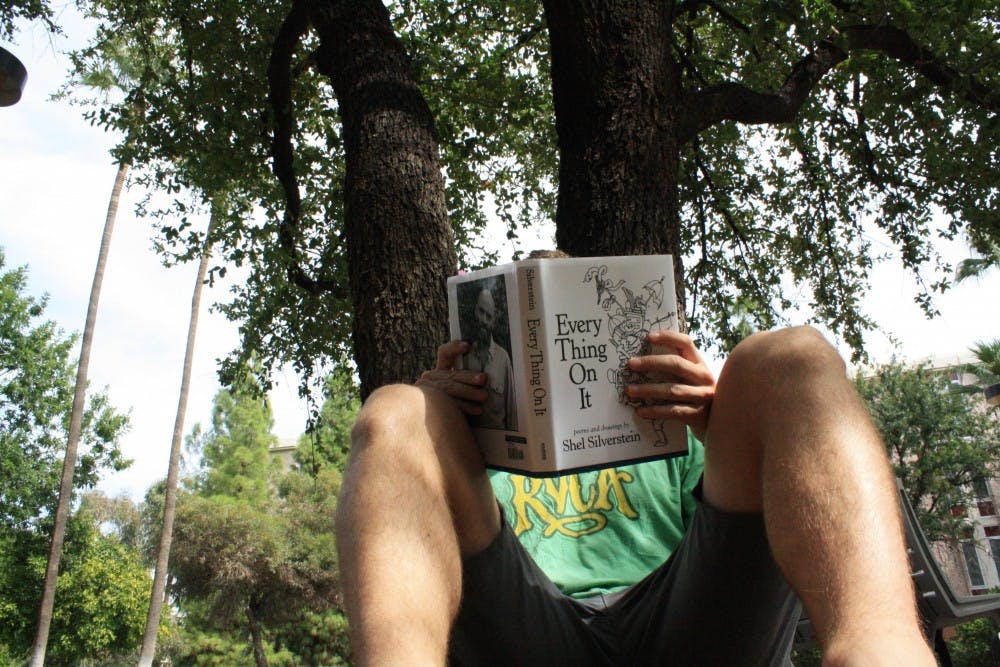 “Come, Boy, sit down. Sit down and rest./ And the boy did./ And the tree was happy.” (Silverstein, The Giving Tree) Fifth year architecture student Jordan Snittjer enjoys a Silverstein classic.
“Come, Boy, sit down. Sit down and rest./ And the boy did./ And the tree was happy.” (Silverstein, The Giving Tree) Fifth year architecture student Jordan Snittjer enjoys a Silverstein classic.Photo by Noemi Gonzalez
Are you in a hurry to grow up and take responsibility of your life, but also constantly yearn for those simpler years of daily naps and crayons? I can relate.
I am perpetually 6-years-old. Sure, I speak and act like your average, stressed and overworked university student with too many obligations, yet six out of ten times you will still find me curled up with a so-called children’s book.
Five out of six times it will be Shel Silverstein.
As the author of classic children’s stories and poems such as Where the Sidewalk Ends, The Giving Tree and Falling Up, Silverstein’s writing can connect to people across all age groups.
Countless times I’ve wondered what is at the end of the sidewalk, what will happen to the boy and the tree, and how I could possibly use Peggy Ann McKay’s endless excuses to justify not going to class.
And whether you know it or not, so have you.
We all like to pretend we’re too cool to read a two-stanza poem about a bitten apple or an exposition about a bargain store selling junk.
But don’t fret about burying yourself forever in the symbolism of Crime and Punishment — it is socially acceptable to enjoy verse with fictional words and unimaginable situations.
Here are six ways Silverstein can relate to the pressures of your busy, university lifestyle.
They will aid you with literary analysis
It happens every semester. An intimidating instructor assigns a text and we must identify the symbolism, metaphors, foreshadowing and diction within. How many times can the color yellow symbolize sickness, anyway?
Instead of succumbing to the traditional analysis from English literature class, you can find the underlying messages in Silverstein’s writing.
What did Jimmy-Jack-John really look for in the dawn? Why did the tree still give to the boy? What did that illustration of “Masks” really mean in regards to society?
After you’ve read stump your teacher by asking them the symbolism behind a flashing blue traffic light with orange and lavender spots. Gain a greater sense of literary dissection that you can brag about after graduation.
They will scare you into horrific paralysis
No, Silverstein’s poems aren’t Paranormal Activity worthy. They don’t talk about exorcisms or zombies crawling out of TVs.
But many of them possess a creepy edge that leaves you uncomfortably squeamish. While you try to convince yourself they are fictional, can you be sure there’s not some monster lurking in your plumbing? If you traveled somewhere, would you be the first one eaten by the native cannibals.
As Halloween approaches, consider using something from Silverstein. You’re friends will raise their eyebrows and ask, “Did he really write that?”
You will drop your Smashburger when you discover the girl who fell into the hamburger grinder and was served hot and fresh to her town. You will stop in your tracks when you uncover the train engineer who died when he tangled his mustache in the train wheels.
And if those terrifying tales aren’t enough, the illustrations will validate Silverstein’s location in the disturbing department. Imagine a boy with a snake entering one end and exiting the other, or another boy with carrots for eyes. And then there’s “Hand Land,” where arms emerge from the ground like something from a bad zombie apocalypse movie.
For some reason, college kids crave the terrifying and disturbing. Now, I’m all for Dean Koontz and Stephen King. But if you don’t have the patience to read an entire book, or the nerves to sit through The House at the End of the Street, I’m sure these will suffice.
They will relieve the stressful days
You have a ten-page paper, two quizzes, a 50-question exam and sociology notes all due tomorrow. But once all is completed, the stress still bounces throughout your brain and chest.
After ten minutes of Silverstein, your heart rate will slow, your blood pressure will fall, and your migraine will fade. You can learn how to get out of drying the dishes, or relate to the boy who wanted a snowball as a pet. I can guarantee reading about polishing the stars will ease you into contentment.
Slow down. Experience some of the foolish folly that we can miss in our fast-moving collegiate years. Temporarily forget that assignment due Friday; you can afford ten minutes to read about “The One Who Invented Trick or Treat.”
They will return you to a childhood haze
We college kids have all become too serious. But Silverstein’s mythical words and random rhymes will slow that subconscious acceleration into the serious business of adulthood.
Silverstein transports you to the days of unadulterated curiosity — far off places, pirates, mermaids, spaceships and talking flowers. The smart aleck, wisecrackers of our classrooms surely attended “Nasty School,” where they learned all the things they weren’t supposed to do but couldn’t help doing anyway.
Nostalgia for the days of pillow forts and rock bands with instruments made from kitchen utensils will not only inspire ceaseless curiosity — you may seriously consider picking up the wooden spoon and pot.
And why not? Maybe ASU needs its own STOMP band.
They will help you cope with ignorant stupidity
We all know that person. That guy or girl who annoys everyone for the sheer fun of their reaction. With Silverstein, you can imagine that person who never says please or thank you being eaten by a crocodile. Or you can picture your roommate who never takes out the trash meeting the same end as Sylvia Stout.
Whether he depicts a woman sporting animal clothing as she campaigns for the rescue of whales, or a man who resorts to using a hammer when his foot falls asleep, Silverstein creates both realizations of irony and acceptable times to laugh at that ironic stupidity.
When you condescendingly chuckle at the people in Silverstein’s words and illustrations who ignorantly shout things across crowds, you are not alone. The visualization of these people meeting any of the horrific circumstances from Silverstein’s poems will provide enjoyment and wit when you cross that overly zealous preacher or abortion picket line.
But most important, they will unleash your creativity
I’m looking at you, engineering major who has been staring at that wiring for three weeks; and you English major who has been rereading that paragraph about elephants and searching for a metaphor; and you justice studies major who has been pouring over that same case study for a month.
Silverstein sees things from a different perspective — his creativity and seemingly simplistic poetry will nudge you toward new ideas. I mean, who else would think that when you ordered a hot dog with everything, your order would include a dresser and a TV?
Ruts and walls will forever challenge college students, whether they are writing that freshman English paper or brainstorming that thesis topic.
Silverstein definitely helped me with writing this article. Did you find the hidden poem?*
Take his ideas, his fun and my advice; go back to that English paper or stressful project with a fresh outlook. You will discover something better and more creative than the person in your class who never thought looked at the world through Silverstein’s eyes.
The four years that are supposed to be the best years of our lives, can sometimes be a grind. But taking the time to read the simplified and diverse writing of Silverstein — both shocking and stress relieving, both nostalgic and useful — can profoundly impact our college experience.
And if not, at least he made us laugh along the way.
*Reread the subheads.
Reach the writer at Mackenzie.McCreary@asu.edu or via Twitter @mackenziemicro







